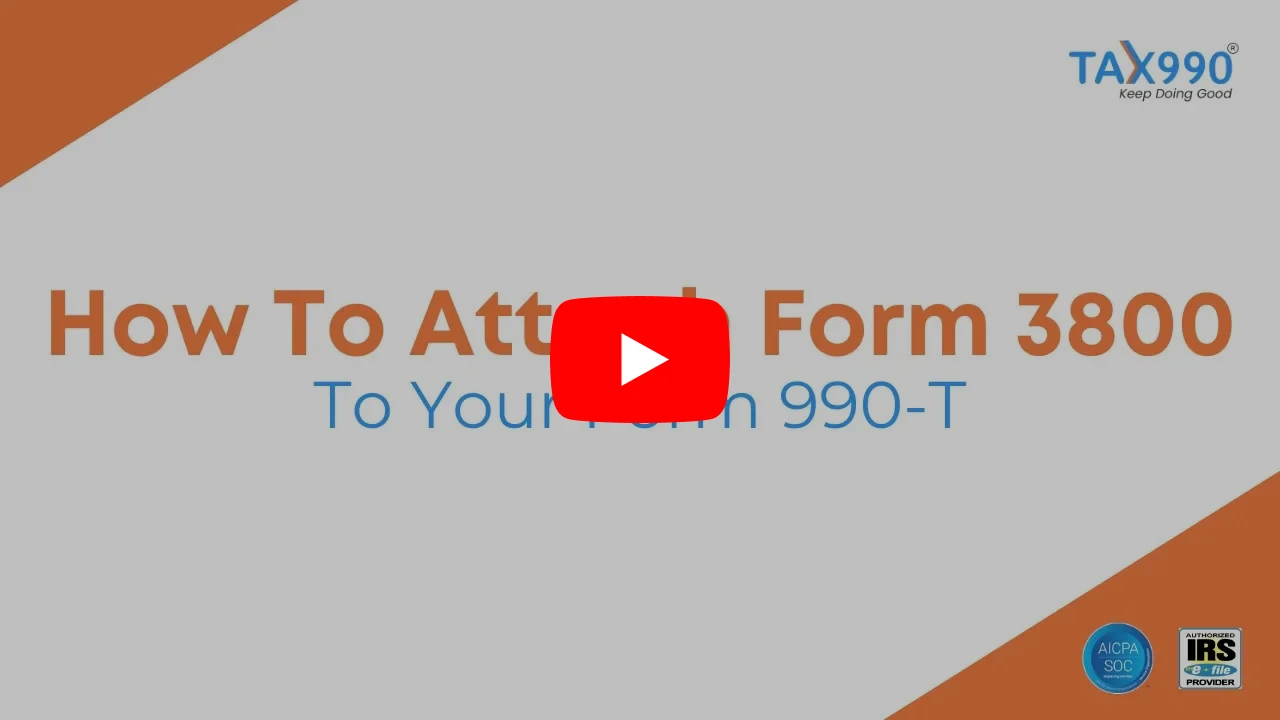- Updated June 26, 2025 - 11.00 AM - Admin, Tax990
Table of Contents
What is Form 3800?
IRS Form 3800, General Business Credit, is used by businesses and eligible tax-exempt organizations to claim a variety of business-related tax credits. These credits are designed to reduce a taxpayer’s overall tax liability by incentivizing certain activities, such as research and development, employment, energy efficiency, and investment in low-income communities.
If a taxpayer is eligible for multiple business-related tax credits, Form 3800 serves as a consolidated reporting tool, ensuring that all credits are properly accounted for and that any limitations on their use are correctly applied.
If your organization is eligible to file Form 990-T, you may need to attach Form 3800 to claim
these credits.
When should I attach 3800 with 990-T?
You should attach Form 3800 when your tax-exempt organization has unrelated business taxable income (UBTI) reported on Form 990-T and is eligible for a general business credit.
For example, if an organization conducts qualified research activities as part of its unrelated business operations, it may claim the Credit for Increasing Research Activities (Form 6765) and report it through Form 3800.
Key IRS Requirements:
- The organization must complete and attach the required credit-specific forms before transferring the amounts to Form 3800.
- The total allowable credit from Form 3800
is then reported on Form 990-T, Schedule C,
Part II. - Any unused credit may be carried back one year or forward up to 20 years, subject to
IRS rules.
What types of tax credits can be claimed using Form 3800?
You can claim various types of business credits by filing Form 3800 based on the criteria established by
the IRS. When filing 3800, you must attach the relevant tax form for the corresponding tax credit you
are claiming.
| Form Number | Credit Name |
|---|---|
|
Form 3468, Part II |
Qualifying Advanced Coal Project Credit and Qualifying Gasification Project Credit |
| Form 7207 |
Advanced Manufacturing Production Credit |
| Form 6765 | Credit for Increasing Research Activities |
|
Form 3468, Part III |
Qualifying Advanced Energy Project Credit Under Section 48C |
| Form 8826 | Disabled Access Credit |
|
Form 8835, Part II |
Renewable Electricity Production Credit |
| Form 7210 |
Clean Hydrogen Production Credit |
| Form 8820 | Orphan Drug Credit |
| Form 8874 | New Markets Credit |
| Form 8881, Part I |
Credit for Small Employer Pension Plan Startup Costs (Including Employer Contributions) |
| Form 8882 |
Credit for Employer-Provided Child Care Facilities and Services |
| Form 8864 | Biodiesel, Renewable Diesel, or Sustainable Aviation Fuels Credit |
| Form 8896 |
Low Sulfur Diesel Fuel Production Credit |
| Form 8906 | Distilled Spirits Credit |
|
Form 3468, Part IV |
Advanced Manufacturing Investment Credit Under Section 48D |
| Form 8908 | Energy Efficient Home Credit |
| Form 8910 | Alternative Motor Vehicle Credit |
| Form 8911, Part II | Credit for Business/Investment Use Part of Refueling Property |
| Form 8830 | Enhanced Oil Recovery Credit |
|
Form 7213, Part II |
Zero-Emission Nuclear Power Production Credit (Section 45U) |
|
Form 3468, Part V |
Investment Credit |
| Form 8932 |
Credit for Employer Differential Wage Payments |
| Form 8933 | Carbon Oxide Sequestration Credit |
|
Form 8936, Part II |
Credit for Business/Investment Use Part of New Clean Vehicles |
|
Form 8936, Part V |
Credit for Qualified Commercial Clean Vehicles |
| Form 8904 | Credit for Oil and Gas Production From Marginal Wells |
| Form 7213, Part I | Credit for Production From Advanced Nuclear Power Facilities (Section 45J) |
| Form 8881, Part II | Small Employer Auto-Enrollment Credit |
|
Form 8881, Part III |
Military Spouse Participation Credit |
|
Form 8864, Line 8 |
Specified Credits |
| Specified Credits | |
|
Form 3468, Part VI |
Energy Credit Under Section 48 |
| Form 5884 | Work Opportunity Credit |
| Form 6478 | Biofuel Producer Credit |
| Form 8586 | Low-Income Housing Credit |
|
Form 8835, Part II |
Renewable Electricity Production Credit |
| Form 8846 | Credit for Employer Social Security and Medicare Taxes Paid on Certain Employee Tips |
| Form 8900 |
Qualified Railroad Track Maintenance Credit |
| Form 8941 | Credit for Small Employer Health Insurance Premiums |
| Form 6765 | Credit for Increasing Research Activities |
| Form 8994 | Employer Credit for Paid Family and Medical Leave |
|
Form 3468, Part VII |
Rehabilitation Credit Under Section 47 |
What information is required to complete 3800?
You’ll need the following information to complete
Form 3800:
- Your organization’s basic details
- Current Year Credit for Credits Not Allowed Against Tentative Minimum
Tax (TMT) - Allowable Credit
- Current Year General Business Credits (GBCs)
- Carryovers of General Business Credits (GBCs) or Eligible Small Business
Credits (ESBCs) - Breakdown of Aggregate Amounts
How to complete IRS Form 3800
Form 3800 (General Business Credit) consists of six parts. Before you start completing them, you must provide your organization’s name as it appears on Form 990-T, along with your identification number and a few other information.
Part I - Credits Not Allowed Against Tentative Minimum Tax (TMT)
- This section calculates the portion of the current year's general business credits that cannot offset the Tentative Minimum Tax. It requires details about the investment property, including passive and non-passive credits, carryforwards to 2025, and carrybacks from 2026.
Generally, tax-exempt organizations filing Form 990-T are not subject to the Tentative Minimum Tax. Therefore, Part I is typically not applicable to Form
990-T filers.
Part II - Figuring Credit Allowed After Limitations
Determines the allowable general business credit for the current tax year by applying limitations based on tax liability. This part has four sections regarding the information on allowable credits.
- Section A—Figuring Credit Allowed After Section 38(c)(1) Limitation Based on Amount of Tax This section requires calculating the credits allowed after section 38(c)(1) limitation, such as calculation of the regular tax before credits, alternative minimum tax using Form 6251 for individuals, Form 4626 for corporations, and Schedule I for estates and trusts, foreign tax credit and credit allowable, foreign tax credit and credit allowable, tentative minimum tax. If there has been an ownership change, acquisition, or reorganization.
-
Section B—Figuring Section 38(c)(2) Empowerment Zone and Community Renewal Employment Credit Allowed Requires the allowed credits for empowerment zone and renewal community employment, general business credit, passive activity credit, and any carryforward or carryback of
business credits. -
Section C—Figuring the Specified Credit Amount Allowed Under
Section 38(c)(4) Requires information regarding remaining credit after adjustment, general and passive activity credit, credit carryforwards to 2024, carrybacks from 2025, and applicable credits. - Section D—Credits Allowed After Limitations In this section, you must provide acquired credit values on the appropriate line for individuals, corporations, or estates and trusts.
Part III - Current Year General Business Credits (GBCs)
This part aggregates all current-year general business credits and eligible small business credits. It has a table where you need to enter the following information for the applicable forms, including:
- Elective payment or transfer registration number
- Pass-through or transfer credit entity EIN
- Credits from non-passive activities
- Credits from passive activities
-
Credit transfer election amount (enter amounts transferred out as a
negative amount) - Gross elective payment election amount
- Net elective payment election amount
Specific to Form 990-T Filers:
The credit amount reported on Line 6, Column J of this part will be reported as the net elective payment election amount on Line 6g of Part III of Form 990-T.
Part IV - Carryovers of General Business Credits (GBCs)
This part summarizes the total credits from Part III and calculates any credit carryforward to future years. It also comprises a table where you have to report the information regarding the carryovers of General Business Credits (GBCs) or Eligible Small Business Credits (ESBCs) for the applicable forms
such as,
- Pass-through entity EIN
- Credit carrybacks to the current year
- Carryforwards (excluding ESBCs)
- Eligible small business credit(ESBC) carryforwards
Part V - Breakdown of Aggregate Amounts on Part III for Facility-by-Facility, Multiple Pass-Through
Entities, etc.
In this part, you need to provide a comprehensive breakdown of the aggregate amounts in Part IV. Here, you’ll be required to enter the following details:
- Line number from Part III
- Elective payment or transfer registration number
- Pass-through or transfer credit entity EIN
- Current year credits from non-passive activities
-
Current year credits from passive activity before passive activity
credit limitation - Credit transfer election amount
- Gross elective payment election amount
- Net elective payment election amount
- Carryover of passive activity credit allowable in the current year
Part VI - Breakdown of Aggregate Amounts in Part IV (see instructions)
This part also requires the breakdown of the aggregate amounts entered in Part IV, which includes:
- Line number from Part IV
- Indication for non-passive credit
- Year
- Pass-through entity EIN
- Credit carrybacks to the current year
- Carryforwards (excluding ESBCs)
- Eligible small business credit (ESBC) carryforward
Easily File Your 990-T And Attach Form 3800 Using Tax990!
When e-filing Form 990-T with Tax990, you can seamlessly complete and include Form 3800 at no additional cost. Our platform ensures that tax-exempt organizations can claim eligible business credits
with ease.
-
Form-Based Filing – Enter information directly on Form 990-T and attach Form 3800 in a structured,
step-by-step process. -
Internal Audit System – Our built-in error-checking tool reviews your form before submission, helping
ensure accuracy. -
Dedicated Support Team – Have questions? Our support team is available to assist you throughout the
filing process. - Reviewers & Approvers Feature – Invite board members to review and approve your forms before submission.


